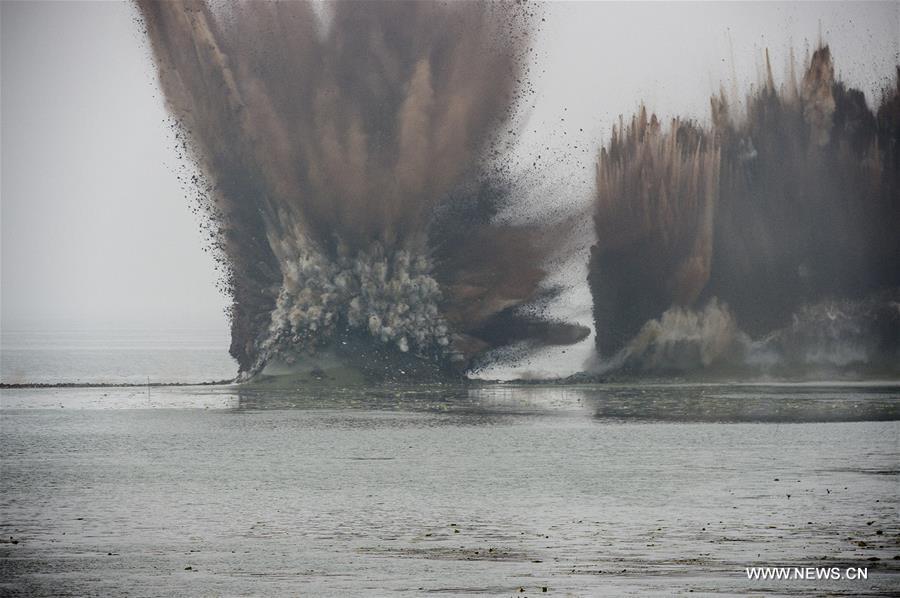


A dike between the Liangzi Lake and the Niushan Lake is blown up in central China's Hubei Province, July 14, 2016. Armed police destroyed the 3.7-kilometer-long embankment separating the Liangzi Lake and the Niushan Lake on Thursday to disperse surging floodwater. (Xinhua/Xiao Yijiu)
WUHAN, July 14 -- Armed police blew up a dike between two lakes in central China's Hubei Province Thursday morning to reduce pressure after heavy rain resulted in record high water levels.
In a southeastern suburb of Hubei's capital Wuhan, the 3.7-km manmade embankment, separating Liangzi Lake and Niushan Lake, was destroyed with 27 tonnes of dynamite at about 7 a.m., according to local authorities.
Liangzi is the second largest lake in Hubei, one of the regions worst hit by the recent fatal bout of rain since mid-June, which has seen the water at the lake rise to 0.12 meters above the warning level.
Water at the adjacent Niushan Lake was lower, making the removal of the dike feasible.
Following the explosion, Niushan Lake merged into Liangzi, increasing the surface area of the latter by more than 100 square kilometers to about 370 square kilometers.
A total of 1,658 people were evacuated for the explosion, they will be re-settled.
Zhu Peijiao, 51, was one of the residents to be resettled. She had earned more than 100,000 yuan a year from her fish and crab farms.
"We lived on that for the past 30 years," she said. "After we are relocated, we will have to find another source of income."
Chen Xiexin, Communist Party of China chief with Jiangxia District, Wuhan, said that buildings for those displaced will be constructed in the district. "We will also take into consideration their lives, social security and employment situations," Chen said.
Niushan and Liangzi lakes were actually connected before the 1970s. The dike was built in 1979, splitting them into two separate bodies of water.
"We did that to support aquatic farms," said villager Luo Huixian, 84, who helped build the dike. "But water quality decreased due to industry activity."
According to Li Changan, a professor with China University of Geosciences, the size of lakes in Wuhan shrank from 371 square kilometers in 1987 to 265 square kilometers in 2013.
"This resulted in waterlogging and floods," he said.
Yu Dan with the School of Life Sciences under Wuhan University has called for removal of the dike between Liangzi and Niushan for years, as it "affected not only the lake's flood control ability, but also the ecological environment".
This view was echoed by Chen Min, an official with the Water Resources Commission of Yangtze River. "With the removal of the dike, we expect to see improvements to the water diversion and storage ability of the lake," he said.
Regarding the future, Yu said "people could grow lotus and water chestnut after water quality improves, and they could also profit from tourism."
Day|Week

 Thai most beautiful transgender Nong Poy release new photos
Thai most beautiful transgender Nong Poy release new photos Top 10 livable Chinese cities
Top 10 livable Chinese cities The last primitive tribe in China
The last primitive tribe in China China's first intelligent security robot debuts in Chongqing
China's first intelligent security robot debuts in Chongqing A Total of 3,552 Subscribers Vanish In Two Days; YouTube Closes All Doors to Users’ Inquiries
A Total of 3,552 Subscribers Vanish In Two Days; YouTube Closes All Doors to Users’ Inquiries Out of this world! Futuristic UFO-shaped yacht has its own garden and a stunning underwater viewing deck
Out of this world! Futuristic UFO-shaped yacht has its own garden and a stunning underwater viewing deck An old tea house in Chengdu
An old tea house in Chengdu Furious Customer Crushes All the Buns from Vendor Just Because He Was Given the Wrong Flavor
Furious Customer Crushes All the Buns from Vendor Just Because He Was Given the Wrong Flavor 20 post-90s couples hold ’naked marriage‘ in E. China
20 post-90s couples hold ’naked marriage‘ in E. China Female official wearing traditional Han costume to promote local tourism
Female official wearing traditional Han costume to promote local tourism